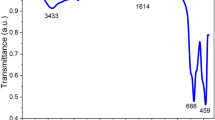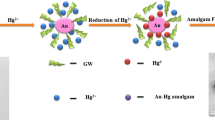Abstract
We have developed an electrochemical sensor for highly selective and sensitive determination of Hg(II). It is based on the specific binding of 5-methyl-2-thiouracil (MTU) and Hg(II) to the surface of an indium tin oxide (ITO) electrode modified with a composite made from graphene oxide (GO) and gold nanoparticles (AuNPs). This leads to a largely enhanced differential pulse voltammetric response for Hg(II). Following optimization of the method, a good linear relationship (R = 0.9920) is found between peak current and the concentration of Hg(II) in the 5.0–110.0 nM range. The limit of detection (LOD) is 0.78 nM at a signal-to-noise ratio of 3. A study on the interference by several metal ions revealed no interferences. The feasibility of this method was demonstrated by the analyses of real water samples. The LODs are 6.9, 1.0 and 1.9 nM for tap water, bottled water and lake water samples, respectively, and recoveries for the water samples spiked with 8.0, 50.0 and 100.0 nM were 83.9–96.8 %, with relative standard deviations ranging from 3.3 % to 5.2 %.

Schematic illustration of the enhanced electrochemical detection strategy for Hg(II) via specific interaction of 5-methyl-2-thiouracil (MTU) and Hg(II) based on graphene oxide and gold nanoparticles (GO-AuNPs) composites modified on the indium tin oxide (ITO) electrode.






Similar content being viewed by others
References
Tchounwou PB, Ayensu WK, Ninashvili N, Sutton D (2003) Environmental exposure to mercury and its toxicopathologic implications for public health. Environ Toxicol 18:149–175
Nolan EM, Lippard SJ (2008) Tools and tactics for the optical detection of mercuric ion. Chem Rev 108:3443–3480
Clemens S, Monperrus M, Donard OFX, Amouroux D, Guerin T (2012) Mercury speciation in seafood using isotope dilution analysis: a review. Talanta 89:12–20
Matusiewicz H, Stanisz E (2012) Evaluation of the catalyzed photo-cold vapour generation for determination of mercury by AAS. J Brazilian Chem Soc 23:247–257
Shekhar R (2012) Improvement of sensitivity of electrolyte cathode discharge atomic emission spectrometry (ELCAD-AES) for mercury using acetic acid medium. Talanta 93:32–36
Zhao YQ, Zheng JP, Fang L, Lin Q, Wu YN, Xue ZM, Fu FF (2012) Speciation analysis of mercury in natural water and fish samples by using capillary electrophoresis–inductively coupled plasma mass spectrometry. Talanta 89:280–285
Yin Z, Wu J, Yang Z (2010) A sensitive mercury (II) sensor based on CuO nanoshuttles/poly(thionine) modified glassy carbon electrode. Microchim Acta 170:307–312
Wang GQ, Chen ZP, Wang WH, Yan B, Chen LX (2011) Chemical redox-regulated mesoporous silica-coated gold nanorods for colorimetric probing of Hg2+ and S2−. Analyst 136:174–178
Wang G, Lim C, Chen L, Chon H, Choo J, Hong J, deMello AJ (2009) Surface-enhanced Raman scattering in Nanoliter droplets: towards high sensitivity detection of mercury (II) ions. Anal Bioanal Chem 394:1827–1832
Wang YQ, Yan B, Chen LX (2013) SERS tags: novel optical nanoprobes for bioanalysis. Chem Rev. doi:10.1021/cr300120g
Li JH, Lu WH, Ma JP, Chen LX (2011) Determination of mercury(II) in water samples using dispersive liquid-liquid microextraction and back extraction along with capillary zone electrophoresis. Microchim Acta 175:301–308
Mandil A, Idrissi L, Amine A (2010) Stripping voltammetric determination of mercury(II) and lead(II) using screen-printed electrodes modified with gold films, and metal ion preconcentration with thiol-modified magnetic particles. Microchim Acta 170:299–305
Pan DW, Wang YE, Chen ZP, Lou TT, Qin W (2009) Nanomaterial/ionophore-based electrode for anodic stripping voltammetric determination of lead: an electrochemical sensing platform toward heavy metals. Anal Chem 81:5088–5094
Chen LX, Zhou N, Li JH, Chen ZP, Liao CY, Chen JN (2011) Synergy of glutathione, dithiothreitol and N-acetyl-L-cysteine self-assembled monolayers for electrochemical assay: sensitive determination of arsenic (III) in environmental and drinking water. Analyst 136:4526–4532
Niu X, Ding Y, Chen C, Zhao H, Lan M (2011) A novel electrochemical biosensor for Hg2+ determination based on Hg2+-induced DNA hybridization. Sensor Actuat B-Chem 158:383–387
Baca AJ, Zhou FM, Wang J, Hu JB, Li JH, Wang JX, Chikneyan ZS (2004) Attachment of ferrocene-capped gold nanoparticle-streptavidin conjugates onto electrode surfaces covered with biotinylated biomolecules for enhanced voltammetric analysis. Electroanalysis 16:73–80
Martín-Yerga D, González-García MB, Costa-García A (2012) Use of nanohybrid materials as electrochemical transducers for mercury sensors. Sensors Actuat B-Chem 165:143–150
Zhou N, Li JH, Chen H, Liao CY, Chen LX (2013) A functional graphene oxide-ionic liquid composites–gold nanoparticle sensing platform for ultrasensitive electrochemical detection of Hg2+. Analyst 138:1091–1097
Song YH, He ZF, Hou HQ, Wang XL, Wang L (2012) Architecture of Fe3O4–graphene oxide nanocomposite and its application as a platform for amino acid biosensing. Electrochim Acta 71:58–65
Pérez-López B, Merkoçi A (2012) Carbon nanotubes and graphene in analytical sciences. Microchim Acta 179:1–16
Boisselier E, Astruc D (2009) Gold nanoparticles in nanomedicine: preparations, imaging, diagnostics, therapies and toxicity. Chem Soc Rev 38:1759–1782
Gan T, Hu S (2011) Electrochemical sensors based on graphene materials. Microchim Acta 175:1–19
Fu XL, Chen LX, Li JH, Lin M, You HY, Wang WH (2012) Label-free colorimetric sensor for ultrasensitive detection of heparin based on color quenching of gold nanorods by graphene oxide. Biosens Bioelectron 34:227–231
Fu XL, Chen LX, Li JH (2012) Ultrasensitive colorimetric detection of heparin based on self-assembly of gold nanoparticles on graphene oxide. Analyst 137:3653–3658
Ma JC, Zhang WD (2011) Gold nanoparticle-coated multiwall carbon nanotube-modified electrode for electrochemical determination of methyl parathion. Microchim Acta 175:309–314
Xi Q, Chen X, Evans DG, Yang WS (2012) Gold nanoparticle-embedded porous graphene thin films fabricated via layer-by-layer self-assembly and subsequent thermal annealing for electrochemical sensing. Langmuir 28:9885–9892
Zhu ZQ, Su YY, Li J, Li D, Zhang J, Song SP, Zhao Y, Li GX, Fan CH (2009) Highly sensitive electrochemical sensor for mercury(II) ions by using a mercury-specific oligonucleotide probe and gold nanoparticle-based amplification. Anal Chem 81:7660–7666
Bernalte E, Marín Sánchez C, Pinila Gil E (2012) Determination of Mercury in indoor dust samples by ultrasonic probe microextraction and stripping voltammetry on gold nanoparticles-modified screen-printed electrodes. Talanta 97:187–192
Sheng Y, Cao XY, Yu M (2012) Electrochemical immunoassay based on gold nanoparticles and reduced graphene oxide functionalized carbon ionic liquid electrode. Microchem J 103:125–130
Liu X, Qi C, Bing T, Cheng X, Shangguan D (2009) Highly selective phthalocyanine−thymine conjugate sensor for Hg2+ based on target induced aggregation. Anal Chem 81:3699–3704
Chen L, Lou TT, Yu CW, Kang Q, Chen LX (2011) N-1-(2-Mercaptoethyl)thymine modification of gold nanoparticles: a highly selective and sensitive colorimetric chemosensor for Hg2+. Analyst 136:4770–4773
Li H, Zhai J, Tian J, Luo Y, Sun X (2011) Carbon nanoparticle for highly sensitive and selective fluorescent detection of mercury(II) ion in aqueous solution. Biosens Bioelectron 26:4656–4660
Xu SF, Chen LX, Li JH, Guan YF, Lu HZ (2012) Novel Hg2+-imprinted polymers based on thymine–Hg2+–thymine interaction for highly selective preconcentration of Hg2+ in water samples. J Hazard Mater 237–238:347–354
Tang XM, Liu HX, Zou BH, Tian DB, Huang H (2012) A fishnet electrochemical Hg2+ sensing strategy based on gold nanoparticle-bioconjugate and thymine–Hg2+–thymine coordination chemistry. Analyst 137:309–311
Gong JM, Zhou T, Song DD, Zhang LZ (2010) Monodispersed Au nanoparticles decorated graphene as an enhanced sensing platform for ultrasensitive stripping voltammetric detection of mercury(II). Sensors Actuat B-Chem 150:491–497
Chen YT, Jiang YY, Lin ZY, Sun JJ, Zhang L, Chen G (2009) Fabrication of an electrically heated indium-tin-oxide electrode for electrochemiluminescent detection system. Analyst 134:731–737
Oh SY, Yun YJ, Kim DY, Han SH (1999) Formation of a self-assembled monolayer of diaminododecane and a heteropolyacid monolayer on the ITO surface. Langmuir 15:4690–4692
Cummins CM, Koivunen ME, Stephanian A, Gee SJ, Hammock BD, Kennedy IM (2006) Application of europium(III) chelate-dyed nanoparticle labels in a competitive atrazine fluoroimmunoassay on an ITO waveguide. Biosens Bioelectron 21:1077–1085
Acknowledgments
This work was financially supported by the Scientific Research Foundation for the Returned Overseas Chinese Scholars, State Education Ministry, the National Natural Science Foundation of China (21275158), and the 100 Talents Program of the Chinese Academy of Sciences.
Author information
Authors and Affiliations
Corresponding author
Rights and permissions
About this article
Cite this article
Zhou, N., Chen, H., Li, J. et al. Highly sensitive and selective voltammetric detection of mercury(II) using an ITO electrode modified with 5-methyl-2-thiouracil, graphene oxide and gold nanoparticles. Microchim Acta 180, 493–499 (2013). https://doi.org/10.1007/s00604-013-0956-0
Received:
Accepted:
Published:
Issue Date:
DOI: https://doi.org/10.1007/s00604-013-0956-0




